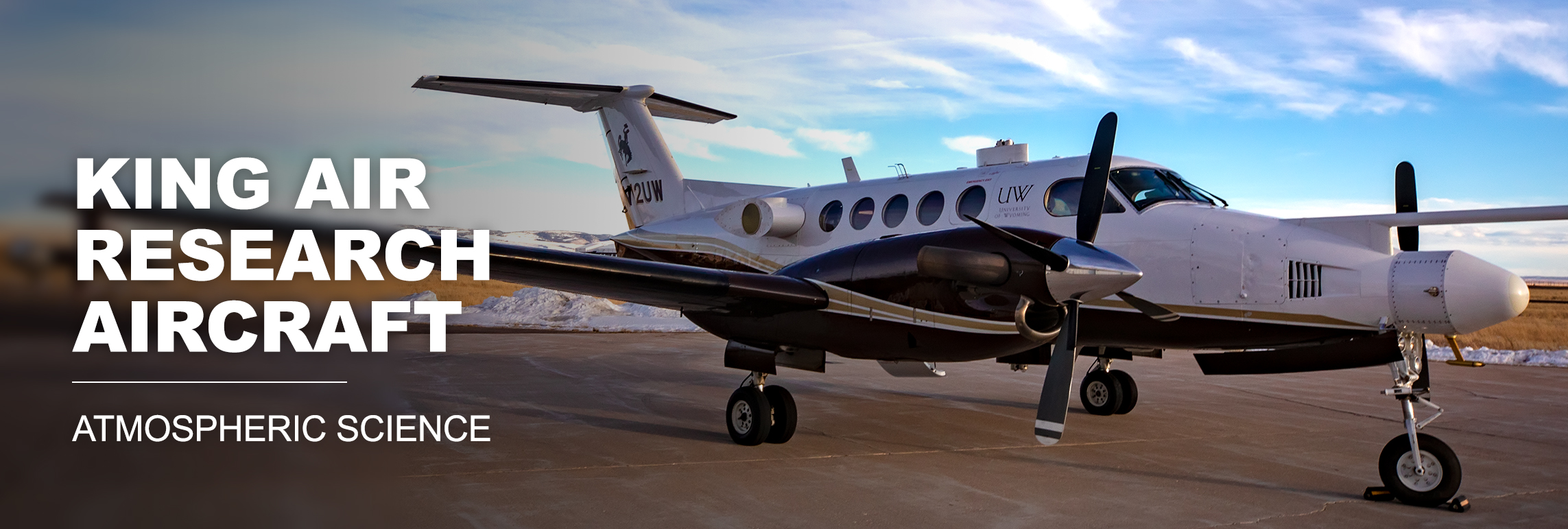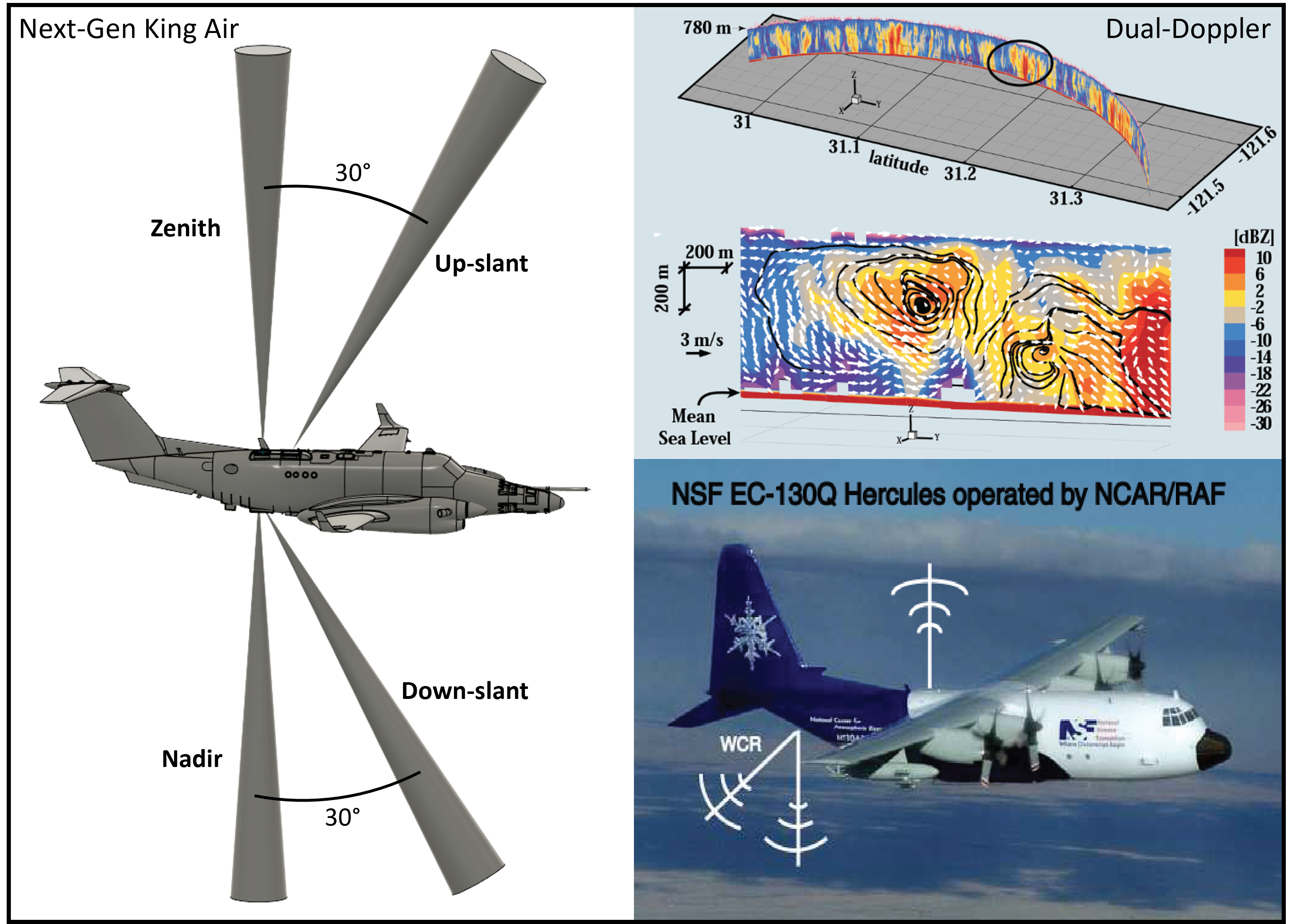


The Wyoming Cloud Radar (WCR) is an airborne polarimetric Doppler radar operating at W-band (94.940 GHz). Up to 4 antennas are employable, and can be configured to observe targets above and below the aircraft. The WCR provides high-resolution measurements of reflectivity and radial velocity, along with the capability of measuring differential reflectivity and linear depolarization ratio. It is deployable aboard both the University of Wyoming King Air and the NSF/NCAR C-130 research aircraft.
University of Wyoming - Flight Center, 1995: University of Wyoming Cloud Radar (WCR). University of Wyoming, College of Engineering, Department of Atmospheric Science, doi:10.15786/M2237S.
Format Citation (ReFindit). Download metadata: XML JSON
For further information concerning the WCR, please contact Dr. Coltin Grasmick.
The Wyoming Cloud Radar (WCR) is an observational system for the study of cloud structure and composition. It is installed principally on the Wyoming King Air, but also on the NSF/NCAR C-130. Operating at 95 GHz (3 mm wavelength), the radar provides high-resolution measurements of reflectivity, velocity and polarization fields. The typical antenna configuration of the WCR (see Modes section) observes a plane, or curtain, along the flight track of the aircraft. By simultaneously using two antennas in this plane (e.g. one in the vertical plane and one forward of vertical), dual-Doppler analysis is possible. Coupled with the in situ observations of hydrometeors and air motions from the same aircraft these data yield unique information for analysis of cloud and precipitation processes.
The WCR may be made available to users of the Wyoming King Air Facility or NSF/NCAR C-130 through the NSF allocation process or by special requests.
Development of the radar was a joint effort with the Microwave Remote Sensing Laboratory of the University of Massachusetts at Amherst. The WCR was manufactured by ProSensing, Inc. (formerly Quadrant Engineering).
Major funding for the acquisition, development and research use of the WCR has been derived from the University of Wyoming, NSF, NASA, and ONR.
Summary table of major developments for the WCR
| Year | WCR revision | Hardware revision | Software revision | Product revision | Remarks |
| 1995 | WCR-1 | New radar | WCR-1 Rev1 | WCR-1 Level 1 | Single antenna |
| 2002 | WCR-1 | RF mods | WCR-1 Rev2 | WCR-1 Level 1 | Four antennas |
| 2004 | WCR-1 | RF mods | WCR-1 Rev3 | WCR-1 Level 1 | Fast antenna switching |
| 2009 | WCR-2 | New radar | WCR-2 Rev1 | WCR-2 Level 1 | Digital receiver |
| 2015 | WCR-3 | RF mods | WCR-3 Rev1 |
WCR-3 Level 1 WCR-3 Level 2 |
New data system |
| 2023 | WCR-4 | RF mods | WCR-4 Rev1 |
WCR-4 Level 1 WCR-4 Level 2 |
Updated components CfRadial2 data format |
Collaboration between the Department of Atmospheric Science, University of Wyoming, and the Microwave Remote Sensing Laboratory (MIRSL), University of Massachusetts, to design, develop, install, and apply a millimeter-wavelength airborne radar, began in 1989 with the first field tests of a radar at the UWyo Elk Mountain Observatory. The radar was first mounted on the UWyo King Air research aircraft and operated with the full set of in-situ probes in fall 1992. Following those first tests, evolving versions of the radar have been used in variety of field programs. Through 1994, a radar unit belonging to UMass was utilized in the experiments. By the time of the Small Cumulus Microphysics Study (SCMS), in July 1995, operations began with the radar, hereafter referred to as WCR (Wyoming Cloud Radar), that was purchased by UWyo with funds from NSF, ONR, and the University of Wyoming Office of Research. The radar has dual polarization and Doppler capabilities.
Since 1995, we participated in a number of field experiments with the WCR mounted on the King Air and in one experiment in which the WCR was mounted on the French research aircraft ARAT. In the summer of 2001 WCR was mounted on the NCAR C-130 and participated in DYCOMSII. WCR was successfully installed on the NRC of Canada Convair-580 for AIRSII, 2003.
The main advantages of the WCR for cloud and precipitation studies are (i) the essentially instantaneous depiction of reflectivity and velocity fields at high spatial resolution and (ii) the coincident observations of detailed microphysics and of air motions by the other probes carried on the aircraft platform. A variety of cloud systems have been already studied with the WCR, in general revealing cloud structure not seen before. As a colloquial expression, one might say that the use of the WCR in cloud studies is as much of a revolution as was the introduction of the PMS probes in the 1970s.
Along with the field studies, significant effort at both UMass and UWyo has been devoted to hardware and software improvements in the radar. These include increases in radar sensitivity, increased flexibility in real-time operation, post-flight data quality control, merging radar with KingAir data, and data display and analysis.
2001-2002: Three additional antennas, as part of the WCR, were installed in the KingAir. Thus the radar can observe targets in vertical(Up), side (latteral to the aircraft axis), side-forward, near nadir, and down-forward directions. Manual RF switches were used to make 2 of the 4 antennas active at any given time.
2003: A new extension in the use of WCR was accomplished. Under a grant funded by NSF EPSCoR program we built a ground based facility where the WCR and RF radiometers can be operated for the purposes of instrument development, training and research.
2004: A new switch network was built to allow pulse-by-pulse switching of the 4 antennas. This allows the radar to quasi-simultaneously observe clouds in all available directions (except for the slow switch between Side and Up directions). Now the WCR can measure cross sections of a cloud in three dimensions and quasi-simultaneous dual-Doppler analysis in vertical and horizontal planes is possible.
Late 2005: We started discussing the development of a new W-band radar that can replace the
current radar. WCR is aging, both, technologically and physically. With WCR-2 we plan
to bring the latest in digital receiver technology, data acquisition, and improved
and more reliable RF design. Higher sensitivity and multi-beam full Doppler spectra
are among the expected exciting improvements and new features. The Department of Atmospheric
Science is teaming with ProSensing, Inc., Pulse Systems, Inc., and EMS Technologies in
the design and the construction of the new radar.
Early 2007: We finished the design of the radar and in August 2008, ProSensing, Inc. delivered
the radar. The radar needed some additional hardware and software work, including
a few issues with the W-band modulator built by Pulse Systems. By August 2009 all
major issues were resolved and the new radar was tested on the Wyoming King Air. September
2009 the radar was declared operational and available for deployment on the Wyoming
King Air and NSF/NCAR C130.
October 2009: The new radar was installed on the NSF/NCAR C130 for its first deployment during
PLOWS 2009-2010 field campaign.
March 2014: WCR-2 has been successfully deployed in 10 field projects so far. A beta version
of level 2 (L2) radar products has been developed and distributed to researches working
on data from ASCII13 and OWLES14. It is our intent to make L2 processed data a standard
product for the coming projects.
The sponsors of the WCR-2 are the University of Wyoming, NSF, and NASA.
September 2013: We started working on a major upgrade of the WCR2. We are modifying the W-band antenna
switch network to increase the receivers' isolation and improve the close range measurements.
Few other modifications to the RF transmitter and the receivers' frontend will be
implemented. We are also replacing the existing 12-bit two-channel digital receiver
with a 16-bit two-channel digital receiver. New and more powerful data system is also
being built that will meet the needs for better polarization and FFT acquisition modes.
New parallel-processing system software and better FFT modes are in the work. WCR-3
will have a new data format, new radar control and real-time display GUIs,and a new
mode configuration tool. WCR2 upgrade is being done in collaboration with ProSensing,
Inc.
We will make maximum efforts to maintain continuity between WCR2 and WCR-3 level 1
(L1) and level 2 (L2) products. L2 will become a standard product for the WCR projects
after 2015.
December 2015: The WCR major upgrade is finished and the radar is fully operational.
The sponsors of the WCR-3 are the University of Wyoming and NSF.
September 2019: UW Atmospheric Science Department is awarded Mid-Scale Research Infrastructure grant by NSF. As part of this grant Wyoming Cloud Radar will go through a major upgrade in addition to transitioning from the current UW King Air Research aircraft to a King Air 350 purchased by UW in 2020. The main antenna configuration for WCR4 in the new King Air will be 4 single-pol antennas - near-nadir, about 30 deg forward of nadir, near zenith and about 30 deg forward of zenith.
January 2023: The WCR upgrade is finished and the radar is fully operational.
The sponsors of the WCR4 are the University of Wyoming and NSF.
Facility Manager:
Jeff French | (307) 766-4143
Project Science and Operations Group:
Associate Facility Manager, group lead: Matt Burkhart | (307) 766-4150
Flight Operations:
Tom Drew | (307) 766-2417
Engineering Group:
Group lead: Nick Mahon | (307) 766-4899